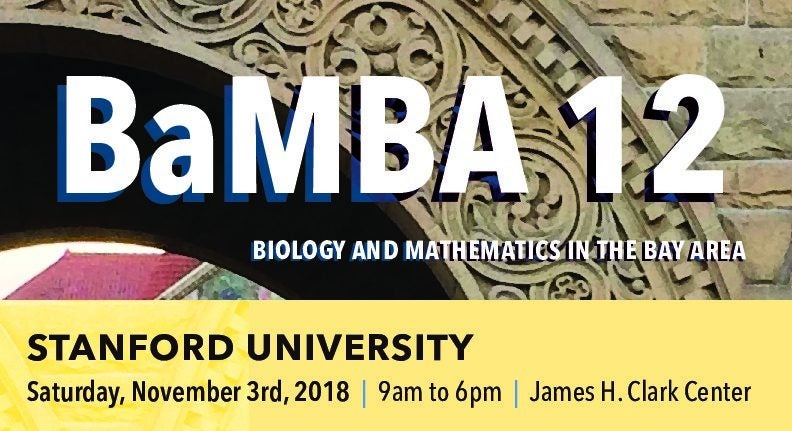Saturday, November 3rd marked the 12th Annual Biology and Mathematics in the Bay Area Conference (BaMBA). BaMBA has developed into a particularly unique conference where you can expect high-level research and opportunities for interdisciplinary collaboration. BaMBA 2018 was held at the incredible Clark Center at Stanford University.
This year’s BaMBA meeting featured five fantastic experts presenting topics ranging from statistical methods in machine learning to cell biology of the immune system: Dr. Lacramioara Bintu (Stanford University) Dr. Sean Collins (UC Davis), Dr. Bin Yu (UC Berkeley), Dr. Dexter Hadley (UC San Francisco), and Dr. Andrew Fire (Stanford University).
I had a chance to speak with Dr. Massa Shoura of Stanford University, an organizer for BaMBA 2018, about what makes BaMBA unique. “What I like about it (sic) brings people together that usually don’t go to the same conferences.” Interdisciplinary conferences like BaMBA are important opportunities for attendees to gain new perspectives on their research.
“As we grow older scientifically we end up specializing and then we end up going to the same conferences and talking to the same people because we are trying to solve something very intricate, but it is nice every now and then for us to get out of our comfort zone and talk to people who we usually dont talk and we find out this person can look at the same problem from a different angle and we end up having diversity in the way we solve the problem.” – Dr. Shoura
Dr. Shoura also pointed out that, because BaMBA is funded from several sources such as UC Davis College of Biological Sciences, the registration fee is waived for all attendees, allowing a broad audience of students, professors, and professionals from across the Bay Area to attend.
Diana Sernas, a 4th year undergraduate student at UCSC (‘19), also thought the accessibility of BaMBA was an important element to the conference’s uniqueness and success. According to her, “[a]ny opportunity for undergraduates to present their work is just another [opportunity for] professional development.” She also presented a research poster about her work on analyzing the 3D architecture of the genome with Dr. Javier Arsuaga.
“Presenting a poster at a conference is a great way for undergraduates to meet other people passionate about science and to see where they might fit in. “We are having an opportunity to look like a scientist, to be a scientist, to present ourselves as scientists.” – Diana Sernas (‘19)
I was especially excited for Dr. Sean Collins’ presentation from the UC Davis Department of Molecular & Cellular Biology. Dr. Collins’ research focuses on understanding the complex regulation of neutrophil chemotaxis vital in the immune response. With the use of live-cell reporters, the Collins lab is able to quantitatively interrogate how neutrophils locate pathogens in complex, noisy environments.
Dr. Collins also pointed out the significant impact BaMBA’s accessibility and well-organized schedule has had on its success: “I think it’s a really great meeting. It’s a nice scale [and] easy to interact with people [even] with a full day… I have also been enjoying breadth of the meeting with really different talks and posters. It’s very nice.”
In addition to the main speakers, sessions/panels, and poster sessions, Q&A sessions offered time to discuss the material and, in some cases, resulted in initiating collaborative projects. Dr. Bin Yu of UC Berkeley “really enjoyed [BaMBA]” and was especially happy “to talk to students and [make] professional connections with other speakers.”
I highly recommend attending BaMBA in the future! It is an unique, accessible conference and an incredible opportunity to meet other passionate scientists. Keep an eye out for information about future BaMBA conferences at the the website: bambameeting.org. You can expect to see me there at BaMBA 13!
Author: Keith Fraga
Editor: Sydney Wyatt
